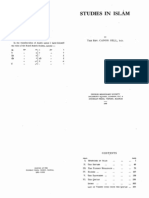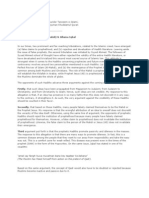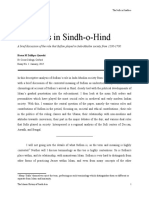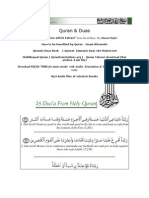Abu Hashim Al-Sufi EI3
Abu Hashim Al-Sufi EI3
Uploaded by
tanvirCopyright:
Available Formats
Abu Hashim Al-Sufi EI3
Abu Hashim Al-Sufi EI3
Uploaded by
tanvirOriginal Description:
Copyright
Available Formats
Share this document
Did you find this document useful?
Is this content inappropriate?
Copyright:
Available Formats
Abu Hashim Al-Sufi EI3
Abu Hashim Al-Sufi EI3
Uploaded by
tanvirCopyright:
Available Formats
abd al-w
id b. zayd
The only work attributed to Abd
al-Qdir is his translation of the Qur n
into Urdu. His brother Raf al-Dn had
completed, around 1201/1786, a first
word-by-word rendering in the Urdu
language. Abd al-Qdir wrote a literary
translation entitled Mzi -i Qu rn (Exposition of the Qur n), a chronogram for
1205/17901, in a simple language easily accessible to a large popular audience,
with clear, brief notes in the margins. This
text marks the beginning of the production, by reformers, of books in the vernacular languages of India, which were
later collectively known as Wahhb
literature and were widely disseminated
through printingfirst typography, and
later lithographybeginning in the early
1820s. Abd al-Qdirs translation was first
published in Calcutta in 1829, through
the efforts of a disciple of Sayyid A mad
Barelw, Sayyid Abdallh, who revised it,
printed it between the lines of the Arabic
text, and made additions to the marginalia. This was the first publication of a
translation of the Qur n in a vernacular
Indian language, and, most remarkably,
the first printing of its Arabic text by Muslims in an Eastern country.
Bibliography
Sources
Abd al-Qdir Dihlaw, Mzi -i Qur n, ed.
Sayyid Abdallh, Calcutta 1829; Garcin de
Tassy, Chrestomathie hindustani (urdu et dakhni)
lusage des lves de lcole royale et spciale des
langues orientales vivantes (Paris 1847), 2235
( Abd al-Qdirs translation of sra 12,
Ysuf ).
Studies
Garcin de Tassy, Mzi -i Qur n, cest--dire
lExposition du Coran (le Coran en arabe,
accompagn dune traduction interlinaire
en hindoustani, Calcutta 1829, Journal des
savants (Paris, July 1834), 43542; Garcin
3
de Tassy, Histoire de la littrature hindouie et
hindoustanie (Paris 187012; repr. New York
1968), 1:769 s.v. Abd ulcadir, 1:817 s.v.
Abdullah; Khwja Ahmad Frq, Urd
main wahhb adab, Delhi 1969; Harlan
O. Pearson, Islamic reform and revivalism
in nineteenth century India. The Tariqa-i
Muhammadiyyah (Ph.D. diss., Duke University 1979), 15560; Saiyid Athar Abbas
Rizvi, Shh Abd al- Azz. Puritanism, sectarianism, polemics and jihd (Canberra 1982), 946,
1035 and passim; Marc Gaborieau, Late
Persian, Early Urdu. The case of Wahhabi literature (18181857), in Franoise
Nalini Delvoye (ed.), Confluence of cultures.
French contributions to Indo-Persian studies (Delhi
1994), 17096; Marc Gaborieau, Traductions, impressions et usages du Coran dans
le sous-continent indien (17861975), RHR
218/1 (2001), 97111; Marc Gaborieau, Le
Mahdi incompris. Sayyid Ahmad Barelw (1786
1831) et le millnarisme en Inde (Paris 2010),
3945, 703, 9496, 1527 and passim.
Marc Gaborieau
Abd al-W id b. Zayd
Abd al-W id b. Zayd (d. c.133/
750) was a disciple of al- asan al-Ba r
(21109/642728, a deeply pious and
ascetic Muslim), who was one of the most
important religious figures in early Islam.
Abd al-W id b. Zayd gained special
prominence for his public sermons, which
emphasised humility and scrupulous conduct, including eating habits. A professional preacher (q ), who was famous for
his eloquence, he painted vivid pictures of
Judgement Day, calling upon his listeners
to prepare themselves for a face-to-face
encounter with God. Each persons righteousness and record of good works, he
argued, would determine how clear this
otherworldly beatific vision will be. Some
of his statements imply that the righteous
might actually experience the delights of
Paradise already in this life, as a reward
abd al-w
for their sincere and disinterested worship
of God. According to Abd al-W id, God
imparts to His righteous friends (awliy ,
sing. wal ) the internal, secret knowledge ( ilm al-b in) of Himself and of the
world, which He conceals from the rest
of his creatures, including the angels. This
sacred trust elevates Gods friends above
other mortals, to occupy a position just
below the prophets. Later f theorists
juxtaposed this internal knowledge with
the so-called external knowledge ( ilm
al- hir), that is, the traditional Islamic sciences such as the Qur n and its commentary, the Prophetic tradition ( adth), and
jurisprudence ( fiqh). It appears that Abd
al-W id considered external knowledge
inferior to the internalan assertion that
many Muslim scholars probably found
heretical.
Abd al-W id belonged to the category
of ascetics whom the sources describe as
weepers. These were pious individuals who wept profusely over their sins
or out of fear of God (khashyat Allh) and
uncertainty about the divine verdict to be
passed on them on Judgement Day. On
a more personal level, weeping could be
caused by the ascetics feeling of weakness
and humility before God and by compassion for those who have strayed from the
right path or for the dead who are no longer able to improve their fate in the hereafter. Through constant mourning, these
beggars of the spirit ( fuqar il llh, literally needy of God) hoped to secure
Gods pleasure and remission of their
sins. Their weeping has a striking parallel
in the early Christian concept of gratia lacrimarum, which characterised many Coptic
and Syrian monks, such as Shenute (Shenoudi, d. 466 C.E.), Ephraem the Syrian (d. 373), John of Ephesus (d. c.586),
and Isaac of Nineveh (d. c.700). It is thus
id b. zayd
hardly surprising that Abd al-W ids
pietistic exhortations refer occasionally to
those Christian monks whose deep disdain
for this world and its sinful inhabitants
he found praiseworthy and encouraged
his followers to emulate. Like the Christian monks, they should keep themselves
entirely apart from the world by forming
a close-knit community united in the common desire to travel on the path to God.
It was apparently with this goal in
mind that Abd al-W id founded the
first f cloister (duwayra), on the island
of Abbdn at the mouth of the Sha
al- Arab. Whether Abd al-W id was
indeed its founder or simply an occasional
resident, Abbdn did become a leading training centre for Muslim ascetics.
It was visited by heroes of later f literature, such as Ab Sulaymn al-Drn
(d. 215/830), Bishr al- f (d. 227/841),
Sar al-Saqa (d. 253/867), and Sahl alTustar (d. 283/896), as well as the great
Qur n commentator Muqtil b. Sulaymn
(d. 150/767 or 159/775), whose exegetical work was important in the birth of the
mystical language of Islam.
Abd al-W id left many disciples, some
of whom distinguished themselves as ascetics. Among them was A mad al- ujaym
(d. late second/eighth century), who is
credited with the establishment of the first
ascetic lodge in Basra. Funded by a waqf
(a charitable endowment), it housed many
of the disciples of al- asan al-Ba r and
Abd al-W id in Basra, assuring the continuity of their teaching.
Bibliography
Ab Nu aym al-I fahn, ilyat al-awliy , 10
vols. (Cairo 19328), 6:1558; F. Meier,
Bakka , EI2; Bernd Radtke (ed.), Adab almuluk. Ein Handbuch zur islamischen Mystikaus
dem 4./10. Jahrhundert (Beirut and Stuttgart
1991), 345 (Arabic text); Margaret Smith,
abdall h b. mu ammad b. abd al-ra m n
Studies in early mysticism in the Near and Middle
East (Oxford 1995), 25, 1267.
Alexander Knysh
Abdallh b. Ja sh
Abdallh b. Ja sh (d. 3/625) was
a leader among the early Muslims who
migrated with the prophet Mu ammad
to Medina in the year 1/622. His sister
Zaynab, who married the Prophet in the
year 5/626 after her divorce from his
adopted son Zayd b. ritha, was also
part of this group. Abdallh b. Ja sh
belonged to the Ban Asad b. Khuzayma
and was a confederate ( alf ) of the Ban
Umayya of Quraysh. His mother was
Umayma bt. Abd al-Mu alib, the aunt
of the Prophet. Abdallhs two brothers, Ubaydallh and Ab A mad, took
part in the migration of early Muslims to
Abyssinia, where Ubaydallh remained
and converted to Christianity. Abdallh
returned to Mecca and joined the migration to Medina (hijra). He led the raid at
Nakhla in 2/624, which was the Muslims
first attack on a Meccan caravan, and the
same year fought at Badr, where the Muslims won a decisive victory. Abdallh b.
Ja sh was martyred the following year at
the battle of U ud, when he was between
forty and fifty years of age. Abdallh b.
Ja sh is often associated in Arabic historical texts with the precedent of the taking
of booty for the community of believers
(khums, ghanma, or fay ).
Bibliography
Ab Hill al- Askar, al-Awa il, ed. Mu ammad
al-Mi r and Wald Qa b (Damascus
1975), 1:175; Ibn Ab Shayba, al-Kitb
al-mu annaf f l-a dth wa-l-thr, ed. mir
al- Umar al-A am. (Bombay 197983),
14:123; Izz al-Dn Ibn al-Athr, Usd
5
al-ghba f ma rifat al- a ba (Cairo 186870),
3:131; Ibn anbal, al-Musnad, ed. A mad
Mu ammad Shkir (Cairo 194989), 3:70.
Ibn Sa d, Kitb al- abaqt al-kabr, ed. Eduard Sachau (Leiden 190440), 3/1:624;
al-Ya qb, al-Ta rkh, ed. M. Th. Houtsma
(Leiden 1883, repr. 1969), 2:6971.
Katherine Lang
W. Montgomery Watt
Abdallh b. Mu ammad b.
Abd al-Ra mn
Abdallh b. Mu ammad b. Abd
al-Ra mn (r. 275300/888912) was
the seventh Umayyad amr of al-Andalus.
His reign was a struggle for survival in the
face of threats that, very early on, put in
danger both his throne and the continued
existence of the Umayyad dynasty in alAndalus. He was designated amr in afar
275/June 888, after the sudden death of
his brother al-Mundhir, who had been
engaged in combat with the rebel Umar
b. af n (d. 305/918). Abdallhs reign
coincided with rebel uprisings in all corners of the Iberian Peninsula and with
conspiracieseither real or imagined
at the court in Crdoba and at the very
heart of the Umayyad family. Abdallh
put an end to all these plots against him
with a firm, cruel hand, ordering the death
of several Umayyads who might have
posed a threat to him, including his sons
Mu ammad, assassinated in 277/891 by
his brother Mu arrif, and Mu arrif himself
in 282/895. The rumour that Abdallh
had been the instigator of his brother
al-Mundhirs poisoningan accusation
that does not seem unwarranted in view
of his later behaviourundermined the
legitimacy of his rule, which, during some
periods, did not extend beyond the limits
of Crdoba itself.
You might also like
- شمائل النبي الشمائل المحمدية تحقيق ماهر الفحلDocument336 pagesشمائل النبي الشمائل المحمدية تحقيق ماهر الفحلm8618446No ratings yet
- The Wayfarer's Lamp (25564)Document110 pagesThe Wayfarer's Lamp (25564)abdulhakimNo ratings yet
- Causes of Separation of East PakistanDocument5 pagesCauses of Separation of East Pakistantanvir93% (40)
- The Last Polymath of The Islamic World SDocument560 pagesThe Last Polymath of The Islamic World SzakhirNo ratings yet
- Sepration of East-PakistanDocument3 pagesSepration of East-Pakistantanvir100% (2)
- The Reason For God - The Problem of SinDocument2 pagesThe Reason For God - The Problem of SinDaveNo ratings yet
- Fons Vitae Book CatalogDocument35 pagesFons Vitae Book Catalogtinto4297No ratings yet
- Ash-Shaykh Badee Ud Deen Shaah Ar Raashidee As SindheeDocument0 pagesAsh-Shaykh Badee Ud Deen Shaah Ar Raashidee As SindheeIbn SadiqNo ratings yet
- Blessings of KhilafatDocument5 pagesBlessings of Khilafatcbtahir2001No ratings yet
- Shabbir - Ahmed.md True History enDocument231 pagesShabbir - Ahmed.md True History ennehal vaghelaNo ratings yet
- From Practice To PoetryDocument8 pagesFrom Practice To PoetrytanvirNo ratings yet
- Jawahir Book 2 Notes Juz 16-30 PDFDocument120 pagesJawahir Book 2 Notes Juz 16-30 PDFعولام الي امير100% (3)
- English Variant Readings Companion Codices and Establishment of The Canonical Text An Analysis The Objections of Arthur Jeffery and at WelchDocument43 pagesEnglish Variant Readings Companion Codices and Establishment of The Canonical Text An Analysis The Objections of Arthur Jeffery and at WelchNeelu BuddyNo ratings yet
- Preaching Islamic Renewal: Religious Authority and Media in Contemporary EgyptFrom EverandPreaching Islamic Renewal: Religious Authority and Media in Contemporary EgyptNo ratings yet
- Shurat Legends, Ibadi Identities: Martyrdom, Asceticism, and the Making of an Early Islamic CommunityFrom EverandShurat Legends, Ibadi Identities: Martyrdom, Asceticism, and the Making of an Early Islamic CommunityNo ratings yet
- The Wahhabi Myth - Salafism, Wahhabism, QutbismDocument3 pagesThe Wahhabi Myth - Salafism, Wahhabism, QutbismRizwan JamilNo ratings yet
- Sufism in South Asia SyllabusDocument7 pagesSufism in South Asia SyllabusNicholas O'ConnellNo ratings yet
- Concept NoteDocument5 pagesConcept Notemuhammedteshome88No ratings yet
- HZT Nizamuddin AuliyaDocument6 pagesHZT Nizamuddin AuliyaShahid Wahab NawabNo ratings yet
- What Is A MadhabDocument8 pagesWhat Is A MadhabAbeenaaz JanallyNo ratings yet
- The Reasons Behind Differences of Opinion by Muhammad Hayat Al SindiDocument34 pagesThe Reasons Behind Differences of Opinion by Muhammad Hayat Al SindiOmar Faruq MilkyNo ratings yet
- 12 Chapter 6Document91 pages12 Chapter 6Mehroz AyubNo ratings yet
- Fitnatul WahabbiyahDocument19 pagesFitnatul WahabbiyahShakil Ahmed100% (1)
- Waliullah IslamDocument4 pagesWaliullah Islammusic2850No ratings yet
- The History of SufismDocument6 pagesThe History of SufismTaha ShahNo ratings yet
- English Islamic Studies Orientalists and Muslim ScholarsDocument68 pagesEnglish Islamic Studies Orientalists and Muslim ScholarsTABRANI. ZANo ratings yet
- A Review of JuynbollDocument10 pagesA Review of JuynbollOlfa BaghniNo ratings yet
- How The Relic of Prophet Muhammad PBUH Reached To BijapurDocument3 pagesHow The Relic of Prophet Muhammad PBUH Reached To Bijapurskquadri7No ratings yet
- Early Muslim History Needs Fresh AppraisalDocument29 pagesEarly Muslim History Needs Fresh Appraisalshafique0% (1)
- RationalityDocument62 pagesRationalityjmohideenkadharNo ratings yet
- Wahhabism 2nd Edition Revised Edited and AnnotatedDocument265 pagesWahhabism 2nd Edition Revised Edited and AnnotatedmausanpraNo ratings yet
- Biography of Allamah Abu Tayyab Muhammad Shams-al-Haq AzimabadiDocument33 pagesBiography of Allamah Abu Tayyab Muhammad Shams-al-Haq AzimabadiUsman A Malik100% (1)
- Ali The MagnificentDocument229 pagesAli The MagnificentAliRaza14No ratings yet
- Sell - Studies in IslamDocument137 pagesSell - Studies in IslamChristine CareyNo ratings yet
- French Doctor's Account of Sheikh Al-AlawiDocument20 pagesFrench Doctor's Account of Sheikh Al-AlawiarfansyedshahNo ratings yet
- Tablighi JammatDocument6 pagesTablighi JammatRajesh JoshiNo ratings yet
- Dawah ParsisDocument4 pagesDawah ParsismuhammadtaimoorkhanNo ratings yet
- Taqiyya The Two-Faced Religion!Document69 pagesTaqiyya The Two-Faced Religion!Asal IslamNo ratings yet
- Hazrat Maulana Yusuf Motala Great Pioneer in The UK PDFDocument8 pagesHazrat Maulana Yusuf Motala Great Pioneer in The UK PDFMD MojibullahNo ratings yet
- The ProphetDocument7 pagesThe ProphetSayeed AkhtarNo ratings yet
- Are Ahadith, The Second Source of IslamDocument22 pagesAre Ahadith, The Second Source of Islamrahenijaat1100% (1)
- Maltese Muslim and EducationDocument130 pagesMaltese Muslim and EducationLouise ChircopNo ratings yet
- A Look at The Life of Khalifa-E-Huzur Mufti-E-Azam-E-Hind, Huzur Mufakkir-I-Islam, Hazrat Allama Qamar-Uz-Zaman Aazmi (Maddazillahul Aali)Document47 pagesA Look at The Life of Khalifa-E-Huzur Mufti-E-Azam-E-Hind, Huzur Mufakkir-I-Islam, Hazrat Allama Qamar-Uz-Zaman Aazmi (Maddazillahul Aali)Gulam-I-Ahmed RazaNo ratings yet
- Abu Anees Barkat AliDocument7 pagesAbu Anees Barkat AliNasir HussainNo ratings yet
- Suing Mufti Ak HoosenDocument8 pagesSuing Mufti Ak HoosenFazel DesaiNo ratings yet
- Slave Girls or ProstitutesDocument9 pagesSlave Girls or ProstitutesSouthern FuturistNo ratings yet
- The Renewal of Islamic LawDocument238 pagesThe Renewal of Islamic Lawwww.alhassanain.org.englishNo ratings yet
- Way To Salvation in The Light of Surah Al-AsrDocument56 pagesWay To Salvation in The Light of Surah Al-AsrBooks for Islam100% (1)
- Zainab (Ra)Document11 pagesZainab (Ra)Nabil Mosharraf HossainNo ratings yet
- Psychology From Islamic PerspectiveDocument22 pagesPsychology From Islamic PerspectiveAl-Faqir Ila Rabbihi Al-QadirNo ratings yet
- Enjoining Morality-Book PDFDocument318 pagesEnjoining Morality-Book PDFTayyib AlNo ratings yet
- MisconceptionsDocument2 pagesMisconceptionsNasrin AktherNo ratings yet
- Alama Iqbal and Imam Mehdi AsDocument3 pagesAlama Iqbal and Imam Mehdi AsUmar Suharwardy0% (1)
- Karbala and Ashura.Document103 pagesKarbala and Ashura.Nauman Abbas GondalNo ratings yet
- CoreListR2 MalikismDocument3 pagesCoreListR2 MalikismBasharath SiddiquiNo ratings yet
- Deviated Sects As They Divided & Split From Pristine IslamDocument3 pagesDeviated Sects As They Divided & Split From Pristine IslamIbn SadiqNo ratings yet
- 10 MaymunaDocument10 pages10 Maymunaapi-3817114100% (2)
- History of HadithDocument24 pagesHistory of HadithadilNo ratings yet
- Sayyid Sulaiman NadviDocument8 pagesSayyid Sulaiman NadviFerry ChandraNo ratings yet
- Sulaiman NadviDocument17 pagesSulaiman NadviSarwanali RajarNo ratings yet
- The Islamic Concept and Its CharacteristicsDocument169 pagesThe Islamic Concept and Its Characteristicsihda0farhatun0nisakNo ratings yet
- Muslim Pilgrimage in the Modern WorldFrom EverandMuslim Pilgrimage in the Modern WorldBabak RahimiNo ratings yet
- Exposing the Khawarij Infiltration of the Blessed Muhammadan NationFrom EverandExposing the Khawarij Infiltration of the Blessed Muhammadan NationNo ratings yet
- Thesis-11 Punjab 1939-1945.Document379 pagesThesis-11 Punjab 1939-1945.tanvirNo ratings yet
- Jamiat Ulema-i-PakistanDocument4 pagesJamiat Ulema-i-PakistantanvirNo ratings yet
- Pak Study AssimentDocument3 pagesPak Study AssimenttanvirNo ratings yet
- Assignment #1Document5 pagesAssignment #1tanvirNo ratings yet
- Uzair KhiljiDocument9 pagesUzair KhiljitanvirNo ratings yet
- Shaikh Farid in Adi Granth Religious IdeDocument28 pagesShaikh Farid in Adi Granth Religious IdetanvirNo ratings yet
- Good Luck!: COMSATS University Islamabad, Virtual Campus HUM111 Pakistan Studies Assignment #4 Fall 2021Document1 pageGood Luck!: COMSATS University Islamabad, Virtual Campus HUM111 Pakistan Studies Assignment #4 Fall 2021tanvirNo ratings yet
- Al KindiDocument12 pagesAl KinditanvirNo ratings yet
- مقدمہ اقتباس الانوار مطبوعہ علی گڑھ جلد اولDocument114 pagesمقدمہ اقتباس الانوار مطبوعہ علی گڑھ جلد اولtanvirNo ratings yet
- Amir Khwurds Use of Sijzi and Barani in Siyar A-AwliyaDocument6 pagesAmir Khwurds Use of Sijzi and Barani in Siyar A-AwliyatanvirNo ratings yet
- Muslims Against Mulism LeagueDocument4 pagesMuslims Against Mulism LeaguetanvirNo ratings yet
- Research MethodsDocument6 pagesResearch MethodstanvirNo ratings yet
- 76-Research Instrument-137-1-10-20210330Document9 pages76-Research Instrument-137-1-10-20210330tanvirNo ratings yet
- The Sufis in Sindh-o-Hind: A Brief Discussion of The Role That Sufism Played in Indo-Muslim Society From 1200-1700Document9 pagesThe Sufis in Sindh-o-Hind: A Brief Discussion of The Role That Sufism Played in Indo-Muslim Society From 1200-1700tanvirNo ratings yet
- Punjabi Language During British Rule Tariq RahmanDocument14 pagesPunjabi Language During British Rule Tariq RahmantanvirNo ratings yet
- 72-Research Instrument-133-1-10-20210328Document10 pages72-Research Instrument-133-1-10-20210328tanvirNo ratings yet
- Question#1: Name: Nouman Raza Section: 1D Roll# 124 Subject: IslamiyatDocument3 pagesQuestion#1: Name: Nouman Raza Section: 1D Roll# 124 Subject: IslamiyattanvirNo ratings yet
- Punjabi in The (Late) Vernacular Millennium: Anne MurphyDocument24 pagesPunjabi in The (Late) Vernacular Millennium: Anne MurphytanvirNo ratings yet
- Saeed Bhutta - The Literary Background of Punjabi Baran MahDocument10 pagesSaeed Bhutta - The Literary Background of Punjabi Baran MahtanvirNo ratings yet
- Introduction and Guidelines For Contributors: ScopeDocument3 pagesIntroduction and Guidelines For Contributors: ScopetanvirNo ratings yet
- Journal of Punjab Studies USADocument143 pagesJournal of Punjab Studies USAtanvirNo ratings yet
- Quran & Duas: Download PDF File 700kb For Main Surahs With Arabic, Translation & Transliteration Verse by VerseDocument34 pagesQuran & Duas: Download PDF File 700kb For Main Surahs With Arabic, Translation & Transliteration Verse by VerseAmjad SiddiqueeNo ratings yet
- The Signs of Qiyamat - DoomsdayDocument7 pagesThe Signs of Qiyamat - DoomsdayM Aamir Sayeed100% (4)
- Bipran Ki Reet To Sach Da Marg-Vol6Document185 pagesBipran Ki Reet To Sach Da Marg-Vol6hardeep100% (4)
- Temple Christology in The Gospel of JohnDocument168 pagesTemple Christology in The Gospel of JohnAbdiel Cervantes Hernandez100% (3)
- Little Flowers AssignmentsDocument2 pagesLittle Flowers AssignmentsShower of RosesNo ratings yet
- Mains 2019-GS-I-Solutions (Orgos IAS) @upsc - Thoughts PDFDocument28 pagesMains 2019-GS-I-Solutions (Orgos IAS) @upsc - Thoughts PDFramNo ratings yet
- Chapter 1 Roles & ResponsibilitiesDocument18 pagesChapter 1 Roles & ResponsibilitieslynelizNo ratings yet
- Anglican: Jivitesh SharmaDocument14 pagesAnglican: Jivitesh SharmaJivitesh SharmaNo ratings yet
- 200+ Quotations For EssayDocument57 pages200+ Quotations For EssaySai NarenderNo ratings yet
- Skanda Guru Kavasam PDFDocument30 pagesSkanda Guru Kavasam PDFfxmanxNo ratings yet
- Pandangan Al-Ghazali Tentang Qadim Dan Baharu Alam Semesta: Suma Hayani, Andi Saputra, Saidul AminDocument14 pagesPandangan Al-Ghazali Tentang Qadim Dan Baharu Alam Semesta: Suma Hayani, Andi Saputra, Saidul AminMIFA 165 TVNo ratings yet
- Maitreyi UpanishadDocument6 pagesMaitreyi UpanishadXynofobNo ratings yet
- Written Debate On Sabbatarianism and Law With An SDA: My Rebuttal PaperDocument24 pagesWritten Debate On Sabbatarianism and Law With An SDA: My Rebuttal PaperJoel SextonNo ratings yet
- Understanding Culture: Youth Ministry Is Cross Cultural MinistryDocument13 pagesUnderstanding Culture: Youth Ministry Is Cross Cultural Ministryinshag7No ratings yet
- Buddhist Saints of The Forest and The Cult of AmuletsDocument429 pagesBuddhist Saints of The Forest and The Cult of AmuletsMarco Guimaraes100% (2)
- Gender, Religion and CasteDocument18 pagesGender, Religion and CasteXpertz BoyNo ratings yet
- Lecture 37. - Covenant of Grace.: SyllabusDocument13 pagesLecture 37. - Covenant of Grace.: Syllabustruthwarrior007No ratings yet
- Vishnu SN in English With MeaningsDocument91 pagesVishnu SN in English With MeaningsBalaji Dhandapani100% (1)
- Comparate Analysis of Confucianism, Daoism and ShitoismDocument35 pagesComparate Analysis of Confucianism, Daoism and ShitoismKaren Mae SibalNo ratings yet
- Orthodox Calendar 2022Document64 pagesOrthodox Calendar 2022ΕΚΚΛΗΣΙΑ Γ.Ο.Χ. ΕΛΛΑΔΟΣ100% (3)
- Mornig Prayer by Father Arsenie BocaDocument2 pagesMornig Prayer by Father Arsenie Bocacristina1604No ratings yet
- Mad HV AcharyaDocument2 pagesMad HV Acharyakrajeev2802No ratings yet
- Our Lady of Peace College Seminary: Diocese of Tarlac San Isidro, Tarlac City C.Y. 2020-2021Document3 pagesOur Lady of Peace College Seminary: Diocese of Tarlac San Isidro, Tarlac City C.Y. 2020-2021Wesley TacadinoNo ratings yet
- The Double Exorcism Cross of ST Benedict and ST AnthonyDocument4 pagesThe Double Exorcism Cross of ST Benedict and ST Anthonymariejun.profitabletradesmenNo ratings yet
- I Will Not Be AfraidDocument1 pageI Will Not Be AfraidMarvin MacalinaoNo ratings yet
- Module 1. ApprovedDocument20 pagesModule 1. ApprovedThursten Kaye Santos SabandalNo ratings yet
- Discovery of GodDocument24 pagesDiscovery of Godssagar_usNo ratings yet
- Boldness in EvangelismDocument1 pageBoldness in EvangelismPoley Nianzou EugeneNo ratings yet

















































































































